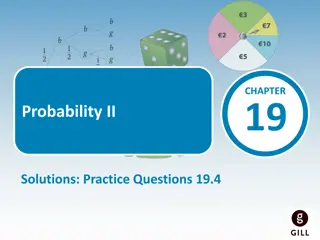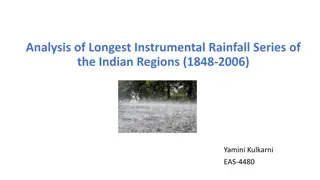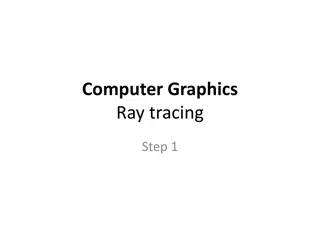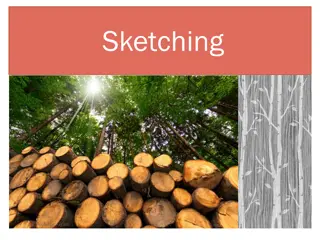Climate and Climatic Regions of Pakistan
Pakistan exhibits diverse climatic regions ranging from sub-tropical continental mountains to arid desert plateaus. Factors like altitude, latitude, and distance from the sea greatly influence the country's climate. The country experiences weather conditions such as temperature variations, rainfall
0 views • 14 slides
Advanced Sequence Analysis with BioEdit Software
BioEdit Software is a versatile tool for sequence alignment and analysis, offering features like color customization, information-based shading, and integration with other programs like ClustalW and Blast. Through its intuitive and graphical interface, users can easily compare sequences, perform Clu
0 views • 12 slides
Creating an Anglo-Saxon House Drawing: A Step-by-Step Guide
Explore the world of Anglo-Saxon houses through a series of activities designed to help you draw your own representation. Follow instructional videos and resources to learn various techniques like drawing 3D shapes, using vanishing points for perspective, and shading to depict different building mat
1 views • 7 slides
Percentages and Fractions
The content covers various examples and explanations related to percentages and fractions. It includes shading squares to determine fractions, calculating percentages of numbers, understanding parts out of a hundred, and solving word problems involving percentages. You can learn how to convert fract
0 views • 17 slides
Regions in Geography
Regions in geography are defined by common features such as climate, landscape, language, or religion. They serve as basic units of geography, with the Middle East being a notable example encompassing political, environmental, and religious characteristics. Regions can be classified based on physica
1 views • 10 slides
Regional Planning and Economic Regions in Geography
Regional planning involves defining regional units, planning regions, and economic regions to ensure sustainable development. It focuses on creating suitable areas for population and employment distribution. The characteristics of planning regions include resource homogeneity, internal coherence, an
0 views • 16 slides
Interactive Lesson on Venn Diagrams and Shading Regions
Dive into a comprehensive tutorial on Venn diagrams highlighting the process of populating and shading regions. Access engaging resources, visual aids, and practice exercises to enhance your understanding. Test your knowledge with a quiz on Hegarty Maths and solidify your skills in displaying sets w
2 views • 15 slides
Population Resource Regions and Zelinsky's Classification
Geographers have long studied the relationship between population growth and resource adequacy, leading to the concept of Population Resource Regions (PRR) by W. Zelinsky. Zelinsky identified five types of PRR based on population-resource ratios, ranging from Type A with high resource utilization po
0 views • 8 slides
Population Distribution in Different Regions of Pakistan
The population distribution in Pakistan varies significantly among different regions, with certain provinces like Punjab and Sindh having higher population densities compared to Baluchistan and FATA. The rural areas are also categorized into different population density regions based on the number o
0 views • 14 slides
A Comparative Overview of World Cultural Regions
Explore the various types of cultural regions and their characteristics around the world, including North America, Latin America, the Middle East, Sub-Saharan Africa, and Europe. Discover how these regions differ in terms of language, religious beliefs, customs, and art forms, providing insight into
1 views • 22 slides
Geography and Five Regions of Wisconsin: Key Points and Natural Features
Wisconsin's geography is influenced by the Great Lakes and the Mississippi River, affecting population distribution based on topography, soil, and climate. The state's historical reliance on soil resources for fur trade, lumber, farming, and manufacturing is evident. Varied regions like the Driftles
3 views • 9 slides
Tonal Shading Drawing Techniques Lesson for Upper KS2
Develop your drawing technique in creating tone with light, medium, and dark tones using cross-hatching, blending, and stippling. Apply these techniques to make objects appear 3D. Explore the importance of tone in drawing, experiment with different shading techniques, and apply them to compositions.
6 views • 6 slides
Sets with Venn Diagrams in Junior Certificate Ordinary Level Mathematics
Dive into the world of sets and Venn diagrams with this educational content designed for Junior Certificate Ordinary Level students. Explore shading regions, identifying subsets, and solving problems using Venn diagrams to enhance your mathematical skills.
1 views • 28 slides
EU Coal Regions Exchange: Pitch Presentation Guidelines for Matchmaking Session
In the upcoming matchmaking session on December 10th, 2021, representatives from EU coal regions will have the opportunity to pitch their ideas for potential exchanges and engage in discussions. Participants are required to prepare a formal pitch slide by December 6th, stick to a strict 90-second ti
0 views • 4 slides
Art Lesson: Drawing Self-Portrait at Home
Practice drawing a self-portrait at home by following step-by-step instructions provided in the content. Start by tracing your face in a mirror, adding features, and creating textures and tones using shading pencils or other materials. Once completed, take a photo of your work and share it with your
1 views • 6 slides
Probability through Venn Diagrams in Practice Questions
Explore various practice questions related to probability using Venn diagrams. From shading regions to calculating probabilities of events, these questions provide a visual and conceptual understanding of probability theory. Topics include intersections, unions, complements, and more.
0 views • 42 slides
Solving Linear Equations and Inequalities in Two Variables
Learn how to solve linear equations and inequalities in two variables by graphing them on a coordinate plane. Understand the steps for graphing inequalities, including determining solid or dashed lines and shading above or below the line. Explore examples and tips for shading regions correctly to fi
0 views • 25 slides
Biodiversity at Reed Hall Pond: A Fascinating Study
The bioblitz pond dip at Reed Hall Pond yielded interesting findings, with 23 different animal species identified, including various insects, aquatic plants, and more. The study also highlighted the impact of shading, potential reasons behind it, and suggested solutions for maintaining a healthy pon
0 views • 10 slides
Comparison of Convective Cores in Gulf and Plains Regions
A detailed comparison of convective cores between Gulf and Plains regions across different seasons reveals interesting patterns. Gulf storms have more cores in the fall, with larger sizes and more cores in winter. The Plains see more cores in the spring season and have generally bigger storms year-r
1 views • 4 slides
Euroscepticism in Border Regions: The Identity Crisis of Europe
Euroscepticism in border regions reflects frustration, disillusionment, and disengagement with the European idea at the borders of the EU. The identity crisis of Europe is showcased through sentiments of dissatisfaction and detachment towards the EU, as evidenced in various border regions. This phen
0 views • 29 slides
Analysis of Longest Instrumental Rainfall Series in Indian Regions
This study by Yamini Kulkarni analyzes the longest instrumental rainfall series in Indian regions from 1848 to 2006. It includes the development of rainfall series for different zones using a network of rain gauge stations and statistical methods to understand fluctuations in precipitation over a 15
0 views • 9 slides
Analysis of CHyM Model Performance in Different Regions
The study evaluates the performance of the CHyM model in humid and arid regions, specifically focusing on Tropical South America and Central America. Through analyzing simulated values, seasonal behavior, and response to ENSO phases, the study provides insights into water resource management in thes
0 views • 16 slides
Enhancing Region Search Queries with Content and Spatial Similarity Measures
This project focuses on developing a system to provide top-k similar regions on a map based on user-specified query regions. By incorporating content and spatial similarity measures, the algorithm aims to accurately retrieve regions with similar shapes, scales, and representative categories. Challen
0 views • 12 slides
The Impact of Artists and Creatives in Border Regions on Culture and Economy
Artists and creatives play a crucial role in the cultural and economic landscape, particularly in border regions where diverse cultures intersect, fostering creativity and innovation. Despite facing challenges, they significantly contribute to social cohesion, the European economy, and the cultural
2 views • 21 slides
Linear Inequalities in Two Variables
Explore the concept of linear inequalities in two variables through graphing and modeling real-world situations. Learn how to identify solutions, graph inequalities, and determine shading direction. Practice problems and visual examples enhance understanding of these mathematical concepts.
0 views • 19 slides
Introduction to Computer Graphics Ray Tracing: Step 1
This content introduces the basics of computer graphics ray tracing through steps involving primary rays, spheres, point lights, diffuse shading, and the PPM format. It includes code snippets for generating PPM images and classes like Vec3 and Ray in C++.
0 views • 24 slides
Climatology for Building Design: Essentials and Applications
Explore the fundamentals of climatology for designing sustainable and comfortable built environments. Learn about the influence of climate on architecture, elements of climate, thermal comfort, natural ventilation, site climate, day lighting, shading devices, and more. Delve into the study of weathe
0 views • 9 slides
Fundamentals of Computer Vision and Image Processing
Fundamentals of computer vision cover topics such as light, geometry, matching, and more. It delves into how images are recorded, how to relate world and image coordinates, measuring similarity between regions, aligning points/patches, and grouping elements together. Understanding concepts like shad
0 views • 29 slides
Advanced Techniques in Shape and Illumination Analysis
Exploring cutting-edge methods such as shape recovery from varying illumination and viewpoint, dynamic shape refinement from multi-view video, and depth estimation through photometric stereo constraints. The process involves factorization, compute depth maps, normal field calculations, and final sur
0 views • 13 slides
Shelter Sector Technical Working Group Meeting Highlights & Resources
Shelter Sector Technical Working Group in Turkey earthquake response discussed topics like light and no-damage buildings, environmental perspectives, and programming support for safer dwellings. The meeting agenda covered introductions, ongoing projects, shading kits, and future plans. Key points em
0 views • 14 slides
Euroscepticism in Border Regions: A Deep Dive into Cross-Border Practices and Perceptions
Explore the phenomenon of Euroscepticism in border regions, delving into cross-border practices and perceptions at the EU's internal borders. This study sheds light on how border regions emerge both functionally and institutionally, emphasizing the importance of understanding Euroscepticism in these
0 views • 16 slides
Marine Aquaculture Impacts on Submersed Aquatic Vegetation
The document explores the impacts of structures and shading used in commercial shellfish mariculture activities on submersed aquatic vegetation, particularly seagrasses. It discusses the varying effects of mariculture structures on eelgrass density, productivity, and the potential habitat they provi
0 views • 11 slides
The Behavior of Spotless Active Regions During Solar Minimum
In this work presented at the SPAnet Workshop on Radio Astronomy in 2017, the study analyzed the physical parameters of spotless active regions observed during the solar minimum period from 2007 to 2010. Radio maps at 17 GHz from the Nobeyama Radioheliograph and magnetograms from the Michelson Doppl
0 views • 14 slides
Mastering Sketching Techniques: Oblique, Isometric, and Shading Tips
Learn how to create 3D effects in your sketches using oblique and isometric sketching methods, along with shading techniques to add depth and dimension. Master the art of drawing cubes and other shapes with step-by-step instructions and visual examples. Enhance your sketching skills with tips on hat
0 views • 4 slides
Insights into Marc Olano's Game Development Journey
Dive into the fascinating world of game development through Marc Olano's experiences, from his background in graphics hardware shading to team collaboration and project challenges. Get a glimpse of the evolution of game programming, customer-focused projects, and industry demos, all shaped by years
0 views • 18 slides
OpenGL Shading and Lighting Techniques
Explore the world of OpenGL shading and lighting through lectures on computer graphics. Delve into methodologies, demo examples, importance of lighting, color primers, and shading techniques like Gouraud and Phong. Gain insights into vertex and fragment shaders, different types of lighting, and mate
1 views • 41 slides
Computer Graphics Shading and Light Interactions
Explore the importance of shading in computer graphics to achieve realistic images by considering light-material interactions, surface properties, and viewer perspective. Discover concepts such as light scattering, reflection models, and approximations for solving shading equations.
0 views • 35 slides
Venn Diagrams and Categorical Syllogisms
Venn diagrams, introduced by John Venn, visually represent relationships between different classes. Shading in diagrams signifies empty sets or no overlap between classes. Different types of categorical statements such as universal and particular are illustrated using examples. Explore how Venn diag
0 views • 30 slides
The Elements of Art and Value in Drawing
This content explores the importance of value in art, discussing how light and dark affect objects, create contrast, form, texture, and variety in art pieces. It also delves into techniques and tools like graphite, charcoal, shading, and different pencils to create varying tones and effects in drawi
0 views • 19 slides
Prime Numbers
Exploring the concept of prime numbers and how to identify them between 1 and 100. The process involves recognizing that prime numbers have only two factors - 1 and themselves. The visual representations help in shading non-prime numbers and multiples of 2, 3, and 5. By following the rules outlined,
1 views • 31 slides







































